Healthcare Report: Supporting Individual Journey in HSC, London
VerifiedAdded on 2021/02/19
|7
|1473
|35
Report
AI Summary
This report provides an in-depth analysis of health and social care (HSC) needs, focusing on supporting individual journeys within a multidisciplinary care context. It begins by exploring local community resources and provisions that support integrated care planning, specifically within the London Borough of Brent, highlighting resources like care homes, cultural organizations, and financial assistance organizations. The report then identifies and discusses local unmet needs related to healthcare provision, such as the lack of healthcare professionals for monitoring patient needs and the absence of emergency facilities. A key section differentiates between health and social care providers, outlining their distinct functions and professional requirements, and also details various types of inter-agency care provision. The report evaluates the effectiveness of local resources in meeting individual needs, particularly in relation to a case scenario involving an individual, Jonathan. The conclusion emphasizes the importance of multidisciplinary care, the assessment of local resources, and the identification of unmet needs to effectively plan for healthcare provision. This report is a valuable resource for students on Desklib.
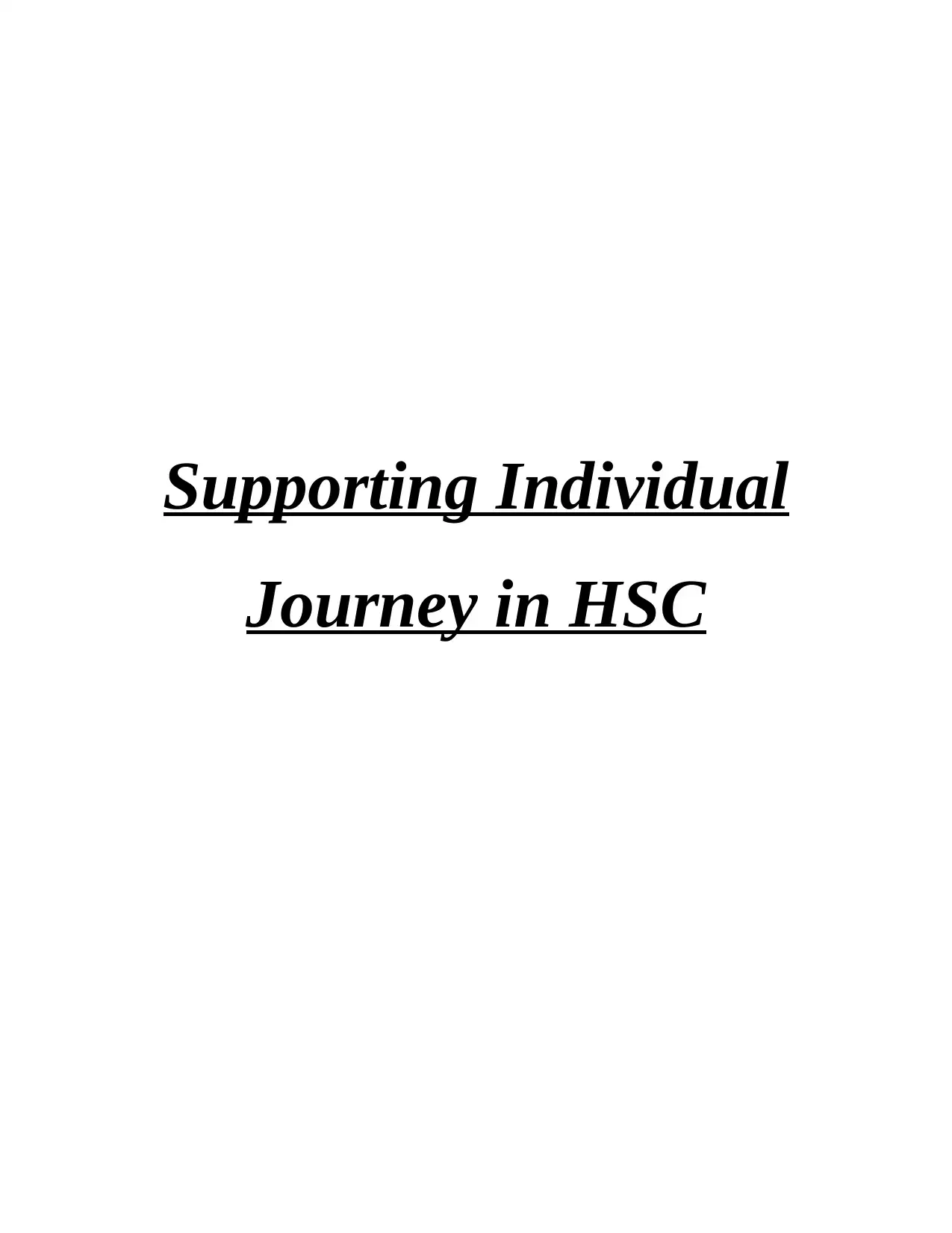
Supporting Individual
Journey in HSC
Journey in HSC
Paraphrase This Document
Need a fresh take? Get an instant paraphrase of this document with our AI Paraphraser
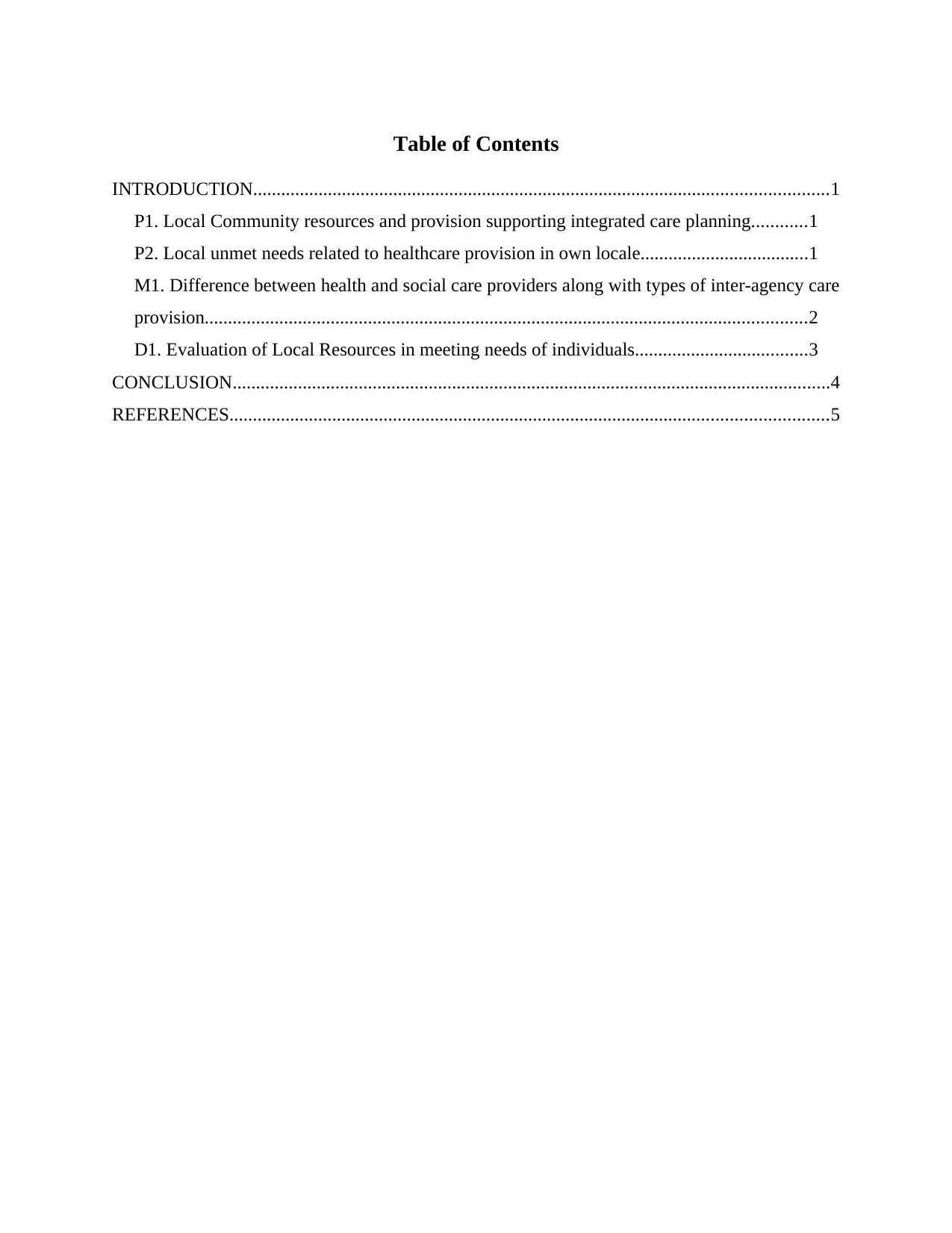
Table of Contents
INTRODUCTION...........................................................................................................................1
P1. Local Community resources and provision supporting integrated care planning............1
P2. Local unmet needs related to healthcare provision in own locale....................................1
M1. Difference between health and social care providers along with types of inter-agency care
provision.................................................................................................................................2
D1. Evaluation of Local Resources in meeting needs of individuals.....................................3
CONCLUSION................................................................................................................................4
REFERENCES................................................................................................................................5
INTRODUCTION...........................................................................................................................1
P1. Local Community resources and provision supporting integrated care planning............1
P2. Local unmet needs related to healthcare provision in own locale....................................1
M1. Difference between health and social care providers along with types of inter-agency care
provision.................................................................................................................................2
D1. Evaluation of Local Resources in meeting needs of individuals.....................................3
CONCLUSION................................................................................................................................4
REFERENCES................................................................................................................................5

INTRODUCTION
Health and social care assistance is an essential support that needs to be rendered to
personnel who possess physical or mental illness (Thomas, 2017). It becomes imperative for
healthcare entities to provide support to individuals in such a manner that their health and social
care needs and wants are duly met. The present report is conducted upon the examination of
health and social care needs of personnel who are subject to multidisciplinary care. It includes
local community provisions as well as resources that render support to integrated care planning
along with local unfulfilled needs associated with medical provisions within domestic confines.
Further, it constitutes differentiation between health and social care provider. Lastly, it comprises
of forms of inter-agency care provisions and assessment of local resources.
P1. Local Community resources and provision supporting integrated care planning
Integrated care planning is a well established and systematic practice that is linked to the
provision of HSC support to the personnel who are encountered with certain clinical issues. In
order to facilitate this planning, it becomes essential that local community resources are available
and taken into use for the provision of integrated plan for such people. In the confines of London
Borough of Brent, a number of local community resources are available which are briefly
explained below:-
Care Home: This is regarded to be a very valuable resource available in the range of
community for the purpose of rendering care to patients (McCormack and McCance, 2016). This
strives to give facilities such as medical care, social assistance and non-medical amenities for the
purpose of living that gives persons like Jonathan the opportunity to relevantly undertake
healthcare service.
Cultural Organisation: This kind of resources is concerned with cultural as well as
regional services. Such kinds of organisations possess a number of volunteers which strive to
render HSC facilities to personnel having health issues, for free.
Financial Assistance Organisation: These are the types of entities that render financial
aid to people who are unable to carry out their own livelihood.
P2. Local unmet needs related to healthcare provision in own locale
Even though there are a number of effectual community resources, yet there are
unfulfilled needs and wants associated with health care provision within the confines of an
1
Health and social care assistance is an essential support that needs to be rendered to
personnel who possess physical or mental illness (Thomas, 2017). It becomes imperative for
healthcare entities to provide support to individuals in such a manner that their health and social
care needs and wants are duly met. The present report is conducted upon the examination of
health and social care needs of personnel who are subject to multidisciplinary care. It includes
local community provisions as well as resources that render support to integrated care planning
along with local unfulfilled needs associated with medical provisions within domestic confines.
Further, it constitutes differentiation between health and social care provider. Lastly, it comprises
of forms of inter-agency care provisions and assessment of local resources.
P1. Local Community resources and provision supporting integrated care planning
Integrated care planning is a well established and systematic practice that is linked to the
provision of HSC support to the personnel who are encountered with certain clinical issues. In
order to facilitate this planning, it becomes essential that local community resources are available
and taken into use for the provision of integrated plan for such people. In the confines of London
Borough of Brent, a number of local community resources are available which are briefly
explained below:-
Care Home: This is regarded to be a very valuable resource available in the range of
community for the purpose of rendering care to patients (McCormack and McCance, 2016). This
strives to give facilities such as medical care, social assistance and non-medical amenities for the
purpose of living that gives persons like Jonathan the opportunity to relevantly undertake
healthcare service.
Cultural Organisation: This kind of resources is concerned with cultural as well as
regional services. Such kinds of organisations possess a number of volunteers which strive to
render HSC facilities to personnel having health issues, for free.
Financial Assistance Organisation: These are the types of entities that render financial
aid to people who are unable to carry out their own livelihood.
P2. Local unmet needs related to healthcare provision in own locale
Even though there are a number of effectual community resources, yet there are
unfulfilled needs and wants associated with health care provision within the confines of an
1
⊘ This is a preview!⊘
Do you want full access?
Subscribe today to unlock all pages.

Trusted by 1+ million students worldwide
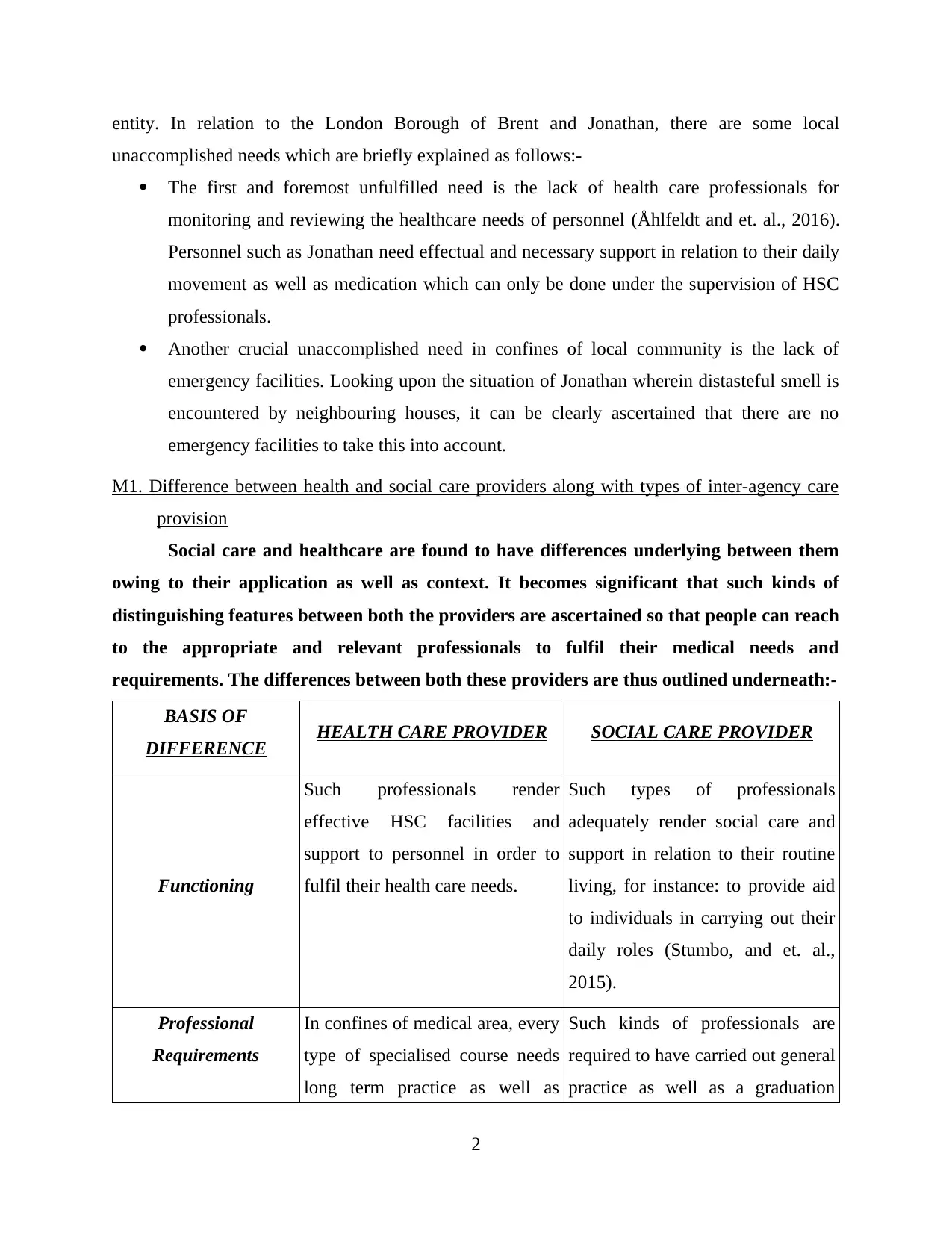
entity. In relation to the London Borough of Brent and Jonathan, there are some local
unaccomplished needs which are briefly explained as follows:-
The first and foremost unfulfilled need is the lack of health care professionals for
monitoring and reviewing the healthcare needs of personnel (Åhlfeldt and et. al., 2016).
Personnel such as Jonathan need effectual and necessary support in relation to their daily
movement as well as medication which can only be done under the supervision of HSC
professionals.
Another crucial unaccomplished need in confines of local community is the lack of
emergency facilities. Looking upon the situation of Jonathan wherein distasteful smell is
encountered by neighbouring houses, it can be clearly ascertained that there are no
emergency facilities to take this into account.
M1. Difference between health and social care providers along with types of inter-agency care
provision
Social care and healthcare are found to have differences underlying between them
owing to their application as well as context. It becomes significant that such kinds of
distinguishing features between both the providers are ascertained so that people can reach
to the appropriate and relevant professionals to fulfil their medical needs and
requirements. The differences between both these providers are thus outlined underneath:-
BASIS OF
DIFFERENCE HEALTH CARE PROVIDER SOCIAL CARE PROVIDER
Functioning
Such professionals render
effective HSC facilities and
support to personnel in order to
fulfil their health care needs.
Such types of professionals
adequately render social care and
support in relation to their routine
living, for instance: to provide aid
to individuals in carrying out their
daily roles (Stumbo, and et. al.,
2015).
Professional
Requirements
In confines of medical area, every
type of specialised course needs
long term practice as well as
Such kinds of professionals are
required to have carried out general
practice as well as a graduation
2
unaccomplished needs which are briefly explained as follows:-
The first and foremost unfulfilled need is the lack of health care professionals for
monitoring and reviewing the healthcare needs of personnel (Åhlfeldt and et. al., 2016).
Personnel such as Jonathan need effectual and necessary support in relation to their daily
movement as well as medication which can only be done under the supervision of HSC
professionals.
Another crucial unaccomplished need in confines of local community is the lack of
emergency facilities. Looking upon the situation of Jonathan wherein distasteful smell is
encountered by neighbouring houses, it can be clearly ascertained that there are no
emergency facilities to take this into account.
M1. Difference between health and social care providers along with types of inter-agency care
provision
Social care and healthcare are found to have differences underlying between them
owing to their application as well as context. It becomes significant that such kinds of
distinguishing features between both the providers are ascertained so that people can reach
to the appropriate and relevant professionals to fulfil their medical needs and
requirements. The differences between both these providers are thus outlined underneath:-
BASIS OF
DIFFERENCE HEALTH CARE PROVIDER SOCIAL CARE PROVIDER
Functioning
Such professionals render
effective HSC facilities and
support to personnel in order to
fulfil their health care needs.
Such types of professionals
adequately render social care and
support in relation to their routine
living, for instance: to provide aid
to individuals in carrying out their
daily roles (Stumbo, and et. al.,
2015).
Professional
Requirements
In confines of medical area, every
type of specialised course needs
long term practice as well as
Such kinds of professionals are
required to have carried out general
practice as well as a graduation
2
Paraphrase This Document
Need a fresh take? Get an instant paraphrase of this document with our AI Paraphraser
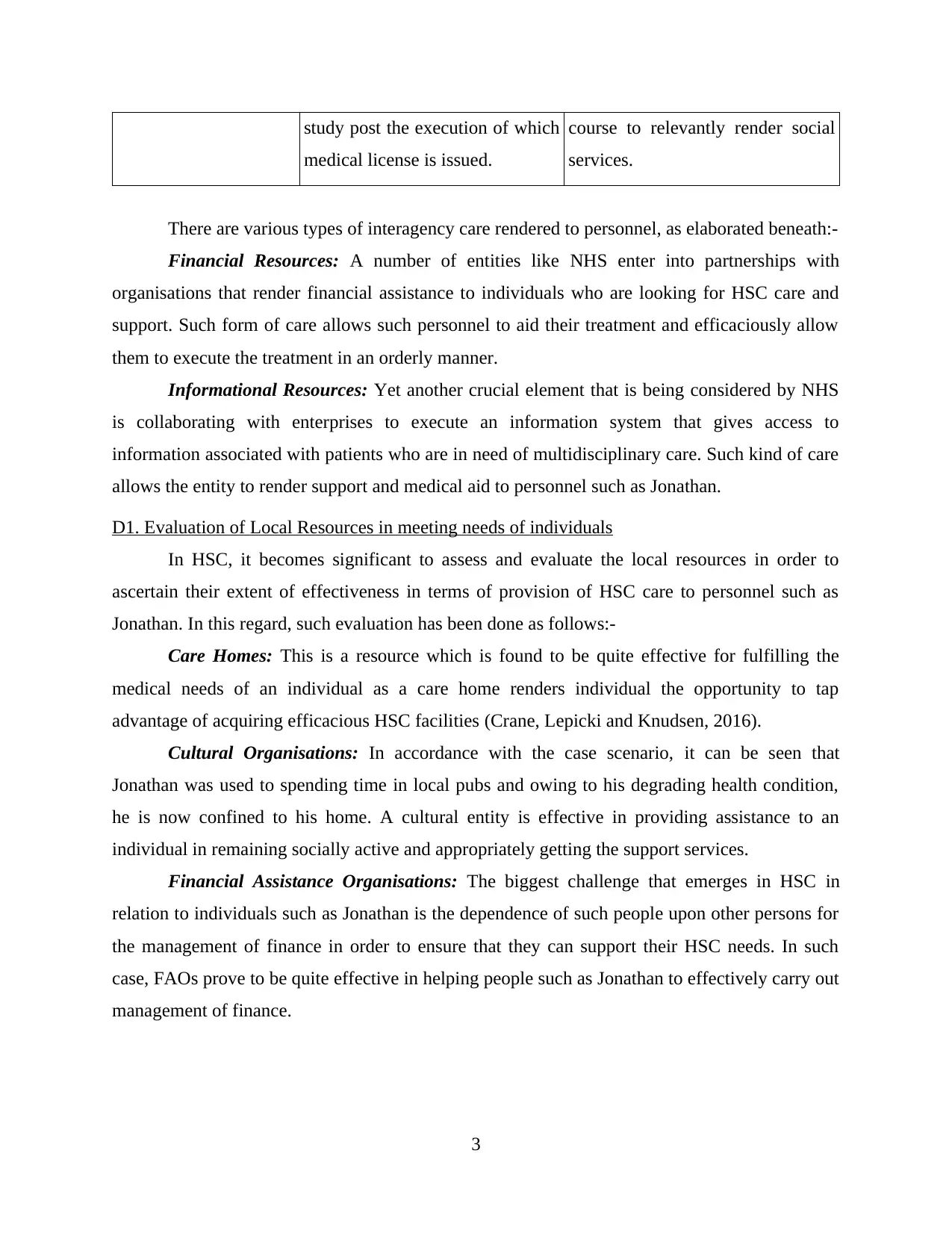
study post the execution of which
medical license is issued.
course to relevantly render social
services.
There are various types of interagency care rendered to personnel, as elaborated beneath:-
Financial Resources: A number of entities like NHS enter into partnerships with
organisations that render financial assistance to individuals who are looking for HSC care and
support. Such form of care allows such personnel to aid their treatment and efficaciously allow
them to execute the treatment in an orderly manner.
Informational Resources: Yet another crucial element that is being considered by NHS
is collaborating with enterprises to execute an information system that gives access to
information associated with patients who are in need of multidisciplinary care. Such kind of care
allows the entity to render support and medical aid to personnel such as Jonathan.
D1. Evaluation of Local Resources in meeting needs of individuals
In HSC, it becomes significant to assess and evaluate the local resources in order to
ascertain their extent of effectiveness in terms of provision of HSC care to personnel such as
Jonathan. In this regard, such evaluation has been done as follows:-
Care Homes: This is a resource which is found to be quite effective for fulfilling the
medical needs of an individual as a care home renders individual the opportunity to tap
advantage of acquiring efficacious HSC facilities (Crane, Lepicki and Knudsen, 2016).
Cultural Organisations: In accordance with the case scenario, it can be seen that
Jonathan was used to spending time in local pubs and owing to his degrading health condition,
he is now confined to his home. A cultural entity is effective in providing assistance to an
individual in remaining socially active and appropriately getting the support services.
Financial Assistance Organisations: The biggest challenge that emerges in HSC in
relation to individuals such as Jonathan is the dependence of such people upon other persons for
the management of finance in order to ensure that they can support their HSC needs. In such
case, FAOs prove to be quite effective in helping people such as Jonathan to effectively carry out
management of finance.
3
medical license is issued.
course to relevantly render social
services.
There are various types of interagency care rendered to personnel, as elaborated beneath:-
Financial Resources: A number of entities like NHS enter into partnerships with
organisations that render financial assistance to individuals who are looking for HSC care and
support. Such form of care allows such personnel to aid their treatment and efficaciously allow
them to execute the treatment in an orderly manner.
Informational Resources: Yet another crucial element that is being considered by NHS
is collaborating with enterprises to execute an information system that gives access to
information associated with patients who are in need of multidisciplinary care. Such kind of care
allows the entity to render support and medical aid to personnel such as Jonathan.
D1. Evaluation of Local Resources in meeting needs of individuals
In HSC, it becomes significant to assess and evaluate the local resources in order to
ascertain their extent of effectiveness in terms of provision of HSC care to personnel such as
Jonathan. In this regard, such evaluation has been done as follows:-
Care Homes: This is a resource which is found to be quite effective for fulfilling the
medical needs of an individual as a care home renders individual the opportunity to tap
advantage of acquiring efficacious HSC facilities (Crane, Lepicki and Knudsen, 2016).
Cultural Organisations: In accordance with the case scenario, it can be seen that
Jonathan was used to spending time in local pubs and owing to his degrading health condition,
he is now confined to his home. A cultural entity is effective in providing assistance to an
individual in remaining socially active and appropriately getting the support services.
Financial Assistance Organisations: The biggest challenge that emerges in HSC in
relation to individuals such as Jonathan is the dependence of such people upon other persons for
the management of finance in order to ensure that they can support their HSC needs. In such
case, FAOs prove to be quite effective in helping people such as Jonathan to effectively carry out
management of finance.
3
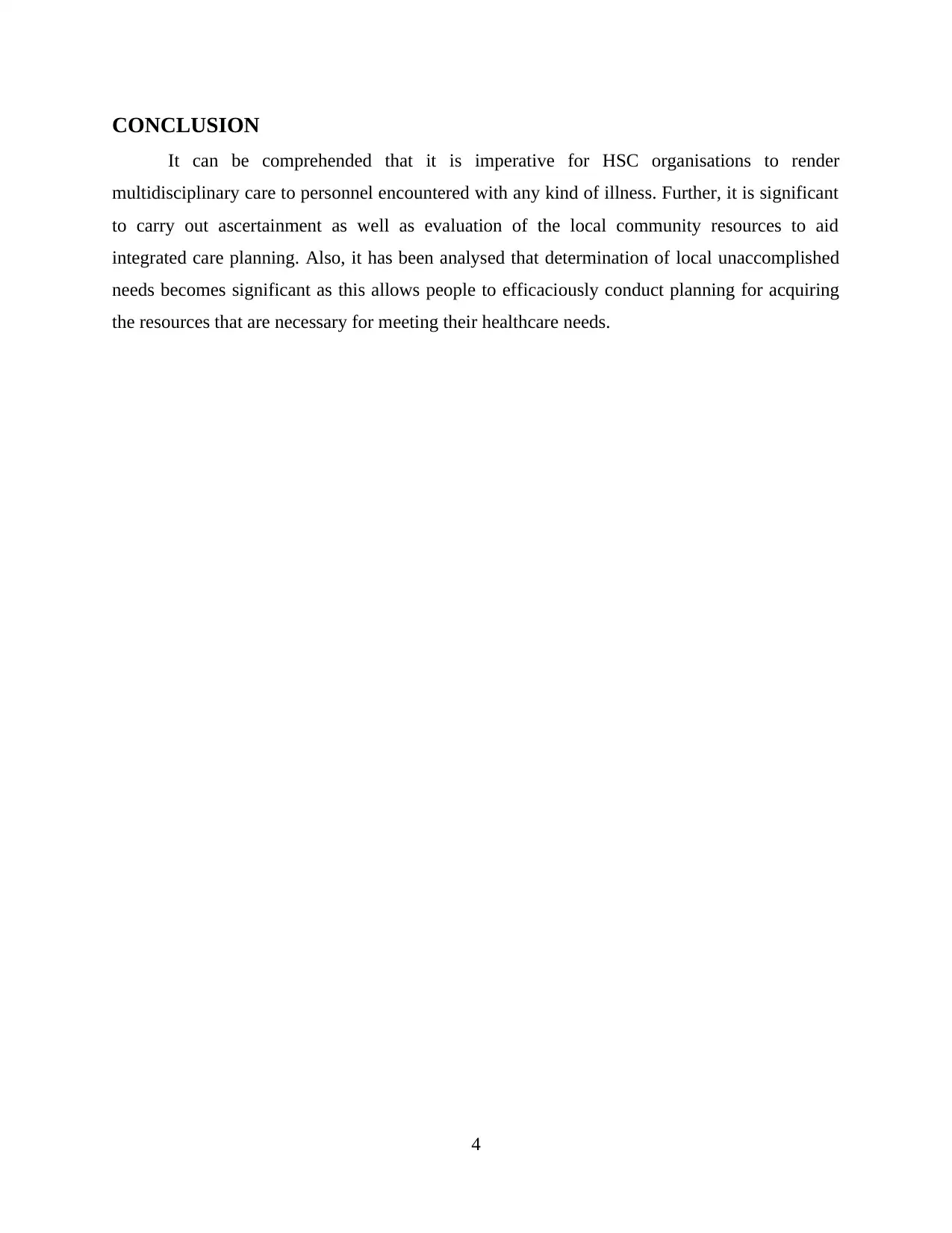
CONCLUSION
It can be comprehended that it is imperative for HSC organisations to render
multidisciplinary care to personnel encountered with any kind of illness. Further, it is significant
to carry out ascertainment as well as evaluation of the local community resources to aid
integrated care planning. Also, it has been analysed that determination of local unaccomplished
needs becomes significant as this allows people to efficaciously conduct planning for acquiring
the resources that are necessary for meeting their healthcare needs.
4
It can be comprehended that it is imperative for HSC organisations to render
multidisciplinary care to personnel encountered with any kind of illness. Further, it is significant
to carry out ascertainment as well as evaluation of the local community resources to aid
integrated care planning. Also, it has been analysed that determination of local unaccomplished
needs becomes significant as this allows people to efficaciously conduct planning for acquiring
the resources that are necessary for meeting their healthcare needs.
4
⊘ This is a preview!⊘
Do you want full access?
Subscribe today to unlock all pages.

Trusted by 1+ million students worldwide
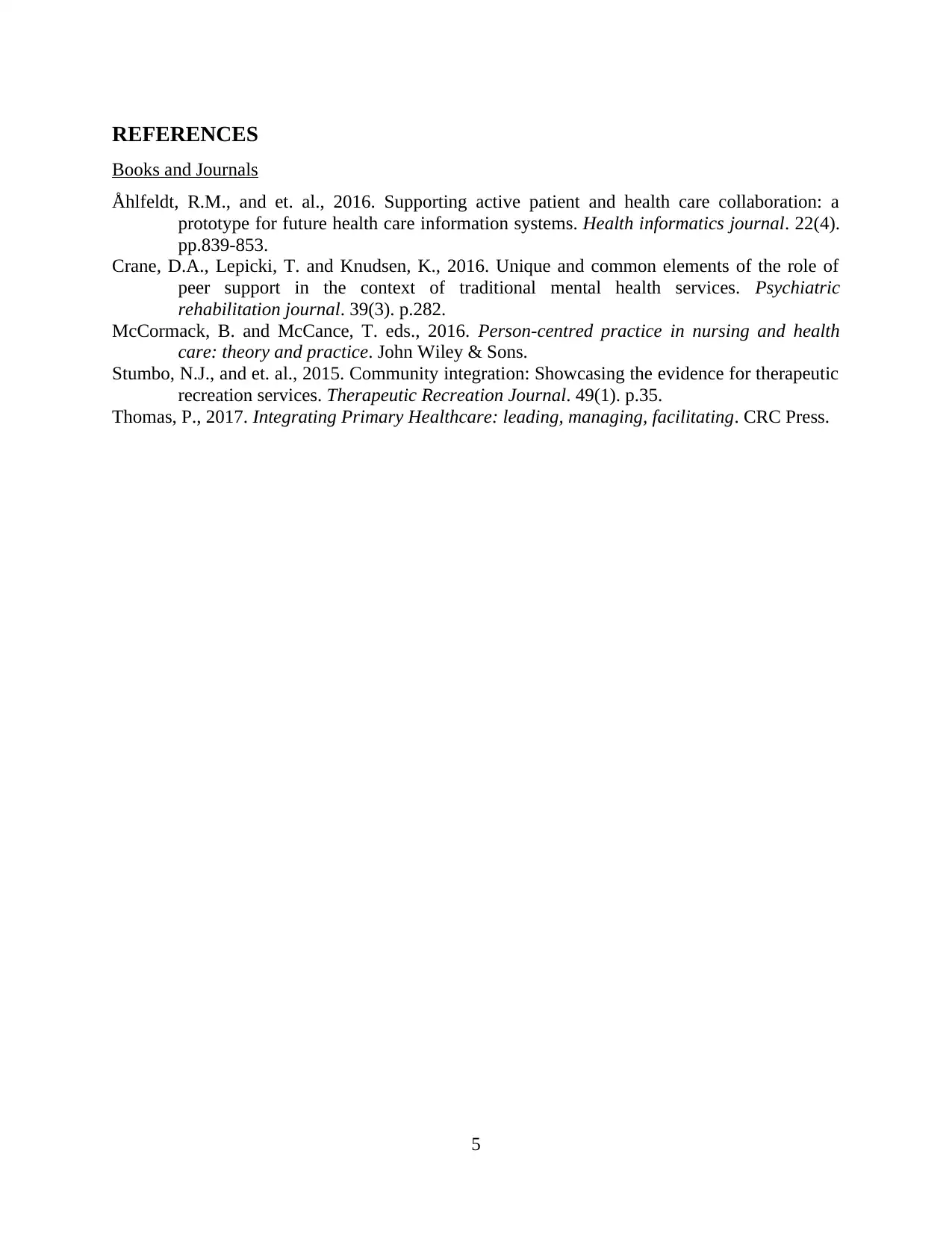
REFERENCES
Books and Journals
Åhlfeldt, R.M., and et. al., 2016. Supporting active patient and health care collaboration: a
prototype for future health care information systems. Health informatics journal. 22(4).
pp.839-853.
Crane, D.A., Lepicki, T. and Knudsen, K., 2016. Unique and common elements of the role of
peer support in the context of traditional mental health services. Psychiatric
rehabilitation journal. 39(3). p.282.
McCormack, B. and McCance, T. eds., 2016. Person-centred practice in nursing and health
care: theory and practice. John Wiley & Sons.
Stumbo, N.J., and et. al., 2015. Community integration: Showcasing the evidence for therapeutic
recreation services. Therapeutic Recreation Journal. 49(1). p.35.
Thomas, P., 2017. Integrating Primary Healthcare: leading, managing, facilitating. CRC Press.
5
Books and Journals
Åhlfeldt, R.M., and et. al., 2016. Supporting active patient and health care collaboration: a
prototype for future health care information systems. Health informatics journal. 22(4).
pp.839-853.
Crane, D.A., Lepicki, T. and Knudsen, K., 2016. Unique and common elements of the role of
peer support in the context of traditional mental health services. Psychiatric
rehabilitation journal. 39(3). p.282.
McCormack, B. and McCance, T. eds., 2016. Person-centred practice in nursing and health
care: theory and practice. John Wiley & Sons.
Stumbo, N.J., and et. al., 2015. Community integration: Showcasing the evidence for therapeutic
recreation services. Therapeutic Recreation Journal. 49(1). p.35.
Thomas, P., 2017. Integrating Primary Healthcare: leading, managing, facilitating. CRC Press.
5
1 out of 7
Related Documents
Your All-in-One AI-Powered Toolkit for Academic Success.
+13062052269
info@desklib.com
Available 24*7 on WhatsApp / Email
![[object Object]](/_next/static/media/star-bottom.7253800d.svg)
Unlock your academic potential
Copyright © 2020–2025 A2Z Services. All Rights Reserved. Developed and managed by ZUCOL.




